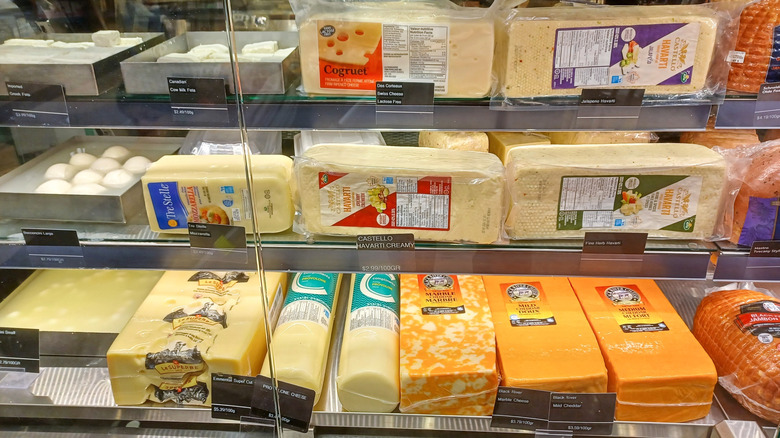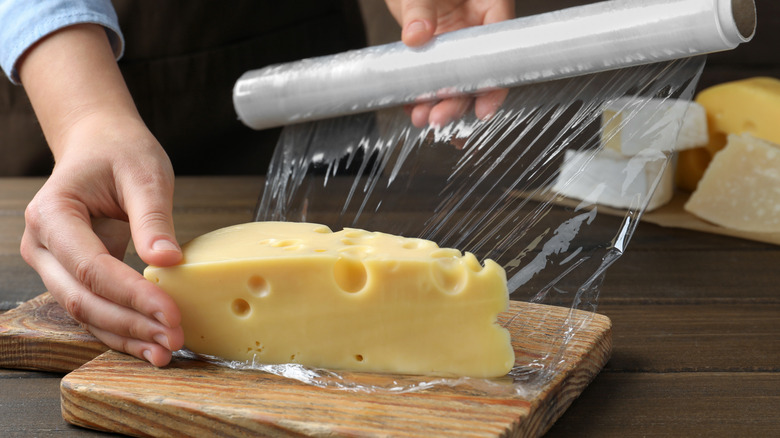The Best Types Of Cheese To Freeze — And How To Do It Right
Sure, you can freeze cheese. But should you? While freezing is not the most ideal storage method, when done properly with the right styles, it's a sustainable solution compared to throwing your wedges away.
As a Certified Cheese Professional and full-time cheesemonger, I'm a firm believer that if you're paying a premium price for a cheese, you want to respect both the artisans and animals that produce it. And you want to think about the hard-earned cash you're shelling out, ensuring every dollar you spend is put to good use. When you buy quality cheese, the intention should be to celebrate and consume it at its pinnacle of freshness.
But then again, there are moments when we need to ditch our high standards and deal with the reality at hand. Was there a huge sale on your favorite cheese? Trying to buy more in bulk to save money? Overestimated how much you needed for a recipe? Freezing is a tempting choice that can actually be put into practice.
Generally, aged cheeses with a developed protein structure and minimal moisture content will freeze well, and those that are fresh with high amounts of contained water will be worse. The water content of the cheese develops into ice crystals when frozen, and with fresher and more delicate cheeses, the protein structure will be too weak to endure freezing and thawing conditions. Embrace the cold, and learn all about the best types of cheese to freeze and how to do it correctly so you can make smarter purchasing and prepping decisions.
Hard aged cheese
Cheeses aged for a significantly long time have a low moisture content, as the maturing process gradually dehydrates a percentage of the water that still remains in the pressed curds. Hard cheese encompasses a wide range of options, as many different styles can be intentionally aged to create a drier final outcome. The more aged and drier a cheese is, the better it will keep in various storage conditions due to its lack of moisture.
Seek out products that are aged for at least six months — though you shouldn't have too much difficulty finding a handful of options in most well-stocked cheese departments that are aged considerably longer, anywhere from one to three years. Common hard aged cheeses include many popular and readily available Italian imports such as Parmigiano Reggiano, Grana Padano, aged Asiago, and aged pecorino cheeses like Pecorino Romano or Pecorino Toscano. Goudas, cheddars, parmesan-style cheeses, and Manchego are also widely available options that are commonly sold in retail at various stages of maturity.
And save those rinds! A smart way to minimize food waste is to save any rinds you have as leftovers from using a wedge of Parmigiano Reggiano. The rind of Parmigiano Reggiano is edible, and is not composed of any synthetic protective coating like wax or plastic. Because it is extremely hard and tough to chew, it is typically not consumed as is, which makes the rind an excellent choice to freeze and add to your cooking. Slowly simmering broth with a rind piece for soups and stews is my go-to trick for developing a unique umami flavor in my dishes.
American cheese
Technically identified as a "pasteurized process cheese" or a "pasteurized process cheese product," most American cheese includes additional ingredients in manufacturing that designate it separately from legal "cheese," according to the United States Food and Drug Administration's Code of Federal Regulations (CFR). The inclusion of emulsifying agents, acidifying agents, gums, butter, cream, whey, and other optional ingredients combine to yield a product with a smooth and meltworthy consistency. In other words, American cheese is America's sweetheart, a hard-to-beat favorite for topping on burgers and cheesesteaks or nestling in grilled cheeses and omelets.
This complicated network of added ingredients also makes American cheese an easy item to freeze, particularly the pre-sliced singles that are already individually wrapped. A processed cheese like this one has a stabilized texture that won't alter drastically when frozen and later thawed.
It's important to note the differentiation between American cheese and Velveeta blocks, another style of processed cheese food. While also not legally considered "cheese," Velveeta has a different list and ratio of ingredients, and does have a tendency to develop a grainy texture once thawed after freezing.
Semi-firm deli-style cheese
This category of lower moisture, semi-firm cheese is a widely available freezer-friendly choice at a happily affordable value. Often found at the deli counter or in vacuum-sealed prepackaged blocks and slices in the refrigerated shelves of the dairy section of grocery stores, these are low-risk and low-price options that react well to freezer storage and the thawing process. You'll find a virtually endless selection of items within this broad classification. Take your pick from commodity favorites like Colby, Colby Jack, Butterkäse, Monterey Jack, Pepper Jack, Havarti, Muenster, and cheddars.
For the best freezing practices, I prefer choosing the cheeses that are already in vacuum-sealed packages. But with just a little extra effort, you can make a shingle of newly sliced deli cheeses work for freezer storage. As long as you have the deli counterperson place wax paper between each layer to prevent sticking, or you can do that at home, there's no stopping you from blissfully listening to the sounds of the deli slicer freshly prepping your ever-growing freezer inventory.
Low-moisture pasta filata cheese
Pasta filata, translated to "spun paste" or "stretched curd" in Italian, is a preparation technique as well as an eponymous Italian cheese category involving repeatedly stretching cheese curds to form a network of elastic and chewy strands. You'll quickly recognize mozzarella and provolone as two popular styles of pasta filata cheese. Caciocavallo and Scamorza are two other lesser-known kinds of pasta filata cheeses, but they are tasty selections if you can locate them in Italian specialty food stores and grocers.
Pasta filata cheeses are as perfect on a pizza as they are in the freezer. But just as water is the enemy that can lead to soggy pizza, it's also mozzarella's enemy when freezing. The low-moisture, part-skim varieties (referred to as LMPS) fare far better in the freezer compared to fresh balls or logs of full-fat mozzarella. Which also means you should keep fresh and creamy burrata away from the freezer. Already a delicate cheese with a short lifespan, burrata's filling of shredded mozzarella soaked in cream is quick to spoil, and certainly won't be living its best life when subjected to severely cold temperatures. Enjoy it exactly as it should be: fresh, fresh, fresh!
Pre-shredded cheese
Perfectly packaged in sealed pouches and mixed with anti-caking agents like powdered cellulose or a mix of starches, bags of pre-shredded cheeses offer a convenient storage option since you can freeze them exactly as they are in their original packaging. Anti-caking agents are useful additions to prevent the strands from sticking together, and they maintain their efficacy when frozen and thawed. Because of the more delicate nature of the feathery strands, any potential textural changes won't be noticeable or inedible.
From simple choices like shredded sharp or mild cheddar and shredded parmesan to fun blends like pizza and Mexican-style, use thawed shredded cheeses as you typically would for cooking and baking in your recipes. But if you're often disappointed in the poor melting qualities of pre-shredded cheese (as helpful as they are, those anti-caking ingredients cause an unfortunate disadvantage), you can also use them as a tasty topper for baked potatoes, pasta dishes, tacos, and salads.
Alpine-style cheese
Famed and adored as being the perfect melters, Alpine-style cheeses are a smart option for freezing if you intend to use them in cooking and baking once thawed. Mixed with other hearty ingredients, they are the ideal choice for using in comforting casseroles like pasta bakes, breakfast bakes, gratins, and stratas. They are all generally aged for a considerable length of time, another reason they freeze better than other fresher styles of cheeses.
True Alpine cheeses include name-protected cheeses such as Comté AOP, Le Gruyère AOP, and Emmentaler AOP made in specific regions of Europe encompassing the Alps with strict guidelines to sourcing and production. Because of their high costs as imports to the United States, in addition to their usage of raw milk, I prefer to not freeze these options if I can absolutely avoid it to secure the integrity of the cheese itself. However, there are a multitude of Alpine-style cheeses at lower price points that serve as better substitutions for storing at freezer temperatures. Try cheeses like Jarlsberg, Fontal, and generic "Swiss" and "Gruyère" cheeses for a taste inspired by the Alps with a more cost-effective receipt.
Stiffer blue cheese
Firm and hardier blue cheeses will freeze better than younger, moister, and more delicate blues that might become gritty after freezing. You'll need to have a slightly discerning eye when determining what a drier blue cheese looks like as you are shopping, but there are some easy clues to recognize. Those with less moisture that have been aged for longer will often feature a drier natural rind, one that is a separate layer from the actual internal paste of the cheese. A perfect example is Stilton, a dense and fudgy cow's milk blue produced in England. Other options include Shropshire Blue, Bayley Hazen Blue, Point Reyes Bay Blue, and Gorgonzola Piccante.
Pre-crumbled blue cheese in sealed tubs would also work for freezer storage, as they also are more solid and drier for that format of blue cheese product. Similar to pre-shredded cheese, crumbled blue cheese often includes the addition of cellulose to prevent the individual pieces from sticking together.
Freezing and thawing tips
When you are preparing a cheese to freeze, there's one major rule to follow: the less air, the better. Cheeses sold already vacuum-sealed are good to go, as long as you have not tampered with the seal. If the cheese already comes in vacuum-sealed packaging, there's nothing else you need to do, as this is an ideal setup that already provides an environment depleted of most oxygen with no risk of air penetration.
If, however, you bought cheese from a monger or deli worker that is loosely wrapped in either plastic wrap or cheese paper, you'll need to create an airtight system that avoids any freezer burn. You can use a kitchen vacuum sealer, or you can wrap the cheese as tightly as possible in a fresh piece of plastic wrap, then place it in an airtight bag or container. To minimize excess air exposure, limit the surface area by freezing whole wedges – it's best to not cut down your cheese any more than how you originally bought it. As with any long-term storage, make sure you have the date of freezing for personal tracking. It will be at its best quality stored no longer than 6 months in the freezer.
For thawing, transfer the cheese from the freezer to the refrigerator and let it gradually thaw for 24 hours before using. Thawed cheese should not be refrozen, and should be used within one week.








